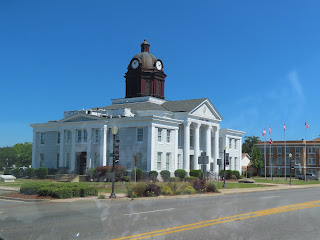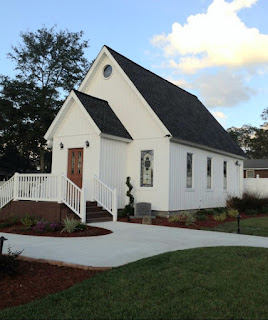We departed Folkston Georgia on US 301 N and quickly turned onto US 1. Folkston is home to The Okefenokee Swamp. It is a shallow, 438,000-acre, peat-filled wetland straddling the Georgia–Florida line. A majority of the swamp is protected by the Okefenokee National Wildlife Refuge and the Okefenokee Wilderness. It is world renowned for its amphibian populations that are bio-indicators of global health. More than 600 plant species have been identified on refuge lands.
We headed into Waycross GA. We missed the truck route and cruised through the heart of Waycross. Along the way, we passed Millie DeShazo Triangle and drove on Ozzie Davis Parkway. Millicent Jackson “Millie” DeShazo, she opened a florist shop and became known as the “flower lady” of Waycross. After retiring she was involved in the Beautification of Waycross and Ware County. She was honored to have the Millie DeShazo Triangle named for her. Ossie Davis, a veteran actor, playwright and film director grew up in Waycross, Georgia.
After Ware County, you enter Bacon County. It was founded in 1914 as the 151st county in Georgia. No, Bacon County is not named after the popular breakfast meat … although I swore I could smell bacon! It received its name in honor of Augustus Octavius Bacon, a four- term US Senator who also served as President Pro Tempore in 1912. Alma, the only incorporated town within county lines, became the county seat. Alma was founded in 1900 as a stop on the Atlantic Coast Line Railroad. It was incorporated as a city in 1906 and designated seat of the newly formed Bacon County in 1914. There are two theories about the origin of the name of the town. The first is that it was named for the wife of a traveling salesmen, Alma Sheridan; the other is that it was named for the initial letter of the four state capitals Georgia has had: Augusta, Louisville, Milledgeville, and Atlanta.
What is the #1 fruit crop in Georgia? Peaches, Peaches, Peaches … everyone who said peaches is wrong! Alma is also the Blueberry Capital of Georgia, and blueberries are the #1 fruit crop in Georgia! Alma is also home to the Georgia Blueberry Festival and tons of growers! It is a locally organized festival. Its goal is to honor and recognize the importance of the blueberry crop to Alma and Bacon County and to thank those who are involved in the production of the blueberries. The Festival provides entertainment, activities, and food to local residents and visitors. 2022 is its 46th year!
As we arrived in Baxley, you are greeted by a beautiful Neoclassical style courthouse. The Appling County Courthouse was built in 1907–1908 at a cost of $50,000. It is constructed of limestone and concrete. Appling County is named for Lieutenant Colonel Daniel Appling, a soldier in the War of 1812. Appling County, the 42nd county created in Georgia, was established by an act of the Georgia General Assembly on December 15, 1818. For a time Appling County was known as the turpentine capital of the world. Residents also constructed timber rafts from cut trees destined for the Darien sawmills. These rafts reached proportions of 25 feet wide by 175 feet in length. A unique rafting and turpentine culture grew out of Appling County.
We passed the Hatch Nuclear Power Plant. It sits on almost 2,500-acre site, along banks of the Altamaha River, from which it draws its cooling water. It was the first nuclear power plant built in Georgia. The plant is home to two boiling water reactors. It has been operating since 1974. The plant is operated by Southern Nuclear on behalf of co-owners Georgia Power, Oglethorpe Power Corporation, Municipal Electrical Authority of Georgia, and Dalton Utilities. In 2018, Hatch became the first commercial reactor in the US to test newer types of fuel developed by the US Department of Energy, which are said to be more accident tolerant.
Right across from the power plant is an RV park, looking at the name I am not sure it is a comforting and welcoming sign!?
As we drove through Georgia, they are turning our Two Lane Adventure into a divided Two Lane Adventure in each direction. We are still OK traveling this way, because it is not an Interstate!
Did you know that there are only two cities in the world named Santa Claus? Well there was three, but one is a ghost town in Arizona. So, there are only two with inhabitants! The uninhabited Santa Claus was located in Mohave County, Arizona. It is now a ghost town that was abandoned 1995. Nina Talbot founded the town in 1937, which attracted attention for its holiday-themed businesses such as the Santa Claus Inn and a children's train called Old 1225. Its popularity soon declined, and the last operating business closed in 1995. One of the remaining Santa Claus, Indiana is located in Spencer County with a population of 2,500. Founded in 1854 as Santa Fe, the name was changed two years later to avoid confusion with another Indiana town of the same name. The post office is now the only one bearing the name Santa Claus and gets thousands of letters to Santa each year.
We traveled through Santa Claus, Georgia, It is located in Toombs County with a population just short of 200. This Santa Claus is too small for a post office, but it still has Candy Cane Street and December Drive to fit the seasonal theme. The small area is dotted with themed business and decorated with garlands and other holiday iconography year-round. There is a beautiful garden and tiny chapel built by local volunteers.
The city of Louisville served as the state capital of Georgia from 1796 to 1806. It was a center of trade, legislators, and political influence. The Jefferson County courthouse, built in 1904, stands on the site of Georgia's first permanent capitol building.
Stuckey’s, the onetime iconic roadside chain known for its teal roofs and pecan rolls, is back in the business of making its own candy. The change occurred in 2021 with the purchase of a family-owned Wrens operation that includes Atwell Pecan Co., Thames Pecan Co. and The Orchards Gourmet. It is the first time for Stuckey’s to own and operate its own pecan and candy plant since it became part of Pet Dairy Corp. in 1964. The company was bought back by the Stuckey family in 1984, although the locations had dwindled from 350 to just a handful.
In early April there was a severe storm and there are still lots of downed trees to show the force of Mother Nature. Look at the size of these trees that were uprooted!
We passed through Harlem, the hometown of Oliver Hardy. We will come back to this town another day. We have tried twice before to visit a great place in this town. I won’t tell you any more today!
The public lands around J. Strom Thurmond Lake offer a wide variety of habitats for numerous species of mammals, birds, and reptiles. In recent years, increased focus has been placed on non-game species, including rare, threatened, and endangered species. The goals of the J. Strom Thurmond Project wildlife management program are to maintain habitat diversity, improve habitat for a variety of game and non-game species, encourage and accommodate public use and appreciation of wildlife resources and, in the case of rare, threatened, or endangered species, to provide optimum habitat conditions and/or protection. Project wide there are 34 wildlife management units ranging in size from 100 to 2,595 acres. Management plans which are prepared for each unit, include specific management objectives, existing activities, and additional work needed. Over 200 food plots are planted in a variety of annual crops, wild fruit trees, and mast producing trees to provide a supplemental source of food for wildlife. More than 26,000 acres of project lands have been leased to the Georgia and South Carolina Departments of Natural Resources for wildlife management. Both states have active programs for game and non-game species. Partnerships with organizations, such as the National Wild Turkey Federation and Quail Unlimited have been beneficial to expanding wildlife management efforts
As we drove over the dam, I wanted to share some facts about the lake. The US Army Corps of Engineers' J. Strom Thurmond Lake is a man-made lake bordering Georgia and South Carolina. The lake is created by the Thurmond Dam. At full pool elevation, Thurmond Lake comprises nearly 71,100 acres of water and 1,200 miles of shoreline. The Thurmond Project was designed for flood control, hydropower, fish and wildlife, water quality, water supply, downstream navigation and recreation. It's one of the top 10 most-visited Corps lakes in the nation!
Crossing the Savannah River, we entered South Carolina.
We arrived at Modoc COE campground, our home for 2 nights!




















No comments:
Post a Comment